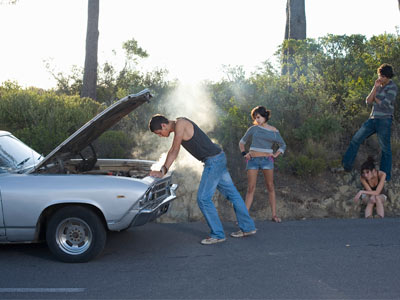Tom Vanderbilt Interview: Drivers Are Disconnected from Other Human Beings (Video)
You Have to See Those Near-Crashes
You Have to See Those Near-Crashes
UK Industry Taskforce on Peak Oil and Energy Security, February 2010
The second report of the UK Industry Taskforce on Peak Oil and Energy Security (ITPOES) finds that oil shortages, insecurity of supply and price volatility will destabilise economic, political and social activity potentially by 2015. Peak Oil refers to the point where the highest practicable rate of global oil production has been achieved and from which future levels of production will either plateau, or begin to diminish. This means an end to the era of cheap oil.

1. Traffic: From 1950 to 1970, the U.S. automobile population grew four times faster than the human
population. As a result, we Americans spent nearly 500,000 years stuck in traffic in 2007 - nearly 4.2
billion hours.
2. Cars Kill Children: The leading cause of death for children aged 5 to 14 in New York City is
pedestrian automobile accidents.
3. Cars Kill Animals: Automobiles, SUVs, trucks, and other fossil field-burning vehicles kill a million
wild animals per week in the U.S. - not counting tens of thousands of family pets.
People move about our cities in many ways. Babies are pushed around in buggies, people with disabilities propel themselves around in electric wheelchairs. People walk or ride bicycles; others catch public transport - buses, trams or trains. Many people rely on carbon-based fuels to power the technology that moves them about: they take their own cars. To support the 'just-in-time' delivery systems, drivers move goods all over our cities many times a day in light vans. Heavy truck drivers take goods to and from the ports and airports.
Executive Summary
This report considers how central government, regional councils, and local authorities
may respond to the transport challenges associated with rising oil prices. This research
supports the environmental sustainability and economic development objectives of the
updated New Zealand Transport Strategy (MOT, 2008b), as well as the specific targets in
the recently released Government Policy Statement on transport (New Zealand
Government, 2008).
Oil currently plays an important role in the transport system in three primary ways.
Firstly, and most obviously, oil provides the fuel that powers the majority of vehicles.
Secondly, oil is the major input into the asphalt and bitumen used to construct and
maintain road surfaces. Finally, the majority of public transport (PT) services are
dependent on diesel – although to a lesser extent than private vehicles.
Thus, when oil prices rise and consumers are faced with higher prices for petrol and
diesel, government agencies are confronted with higher costs for maintaining and
constructing road infrastructure as well as higher costs for operating public transport
services. The price of oil is therefore a key driver of the cost of using, maintaining,
constructing, and operating the transport network.
This report aims to help government agencies understand the risks posed by high oil
prices and, ultimately, recommend changes so that the transport system develops in a
way that is less dependent on oil based transport fuels. The results of this research are
summarised into four key sections, namely: modelling prices for transport fuels,
modelling future travel demands, recommended responses to rising oil prices, and
potential impacts of the responses.
TRAFINZ 2009 brought together over 200 transport professionals and practitioners in Auckland from September 6-9 to discuss the future of land transport, road safety, and planning our cities and towns.
Three Big Themes from the Conference
Theme 1 Transport Future
There was a clear clash of world views between speakers thinking the future will be very like the last 50 years in terms of how we get around, and those who say the world will change and New Zealand risks being left behind. Whatever your world view, the message was scenario planning, New Zealand is not currently in that space.
Theme 2 Safety
We know we will fail horribly in meeting the objectives of the current 2010 Road Safety Strategy. This year 420 – 430 people will die on our roads, the target next year is to get under 300! Transport Minister Steven Joyce said safety is a key element of the increased state highway investment programme. He also discussed ‘Safer Journeys 2020’ saying ‘I want an action plan out of it’. Disappointingly he said of the 60 initiatives proposed ‘it is not Government’s intention to introduce anywhere near all of those items’.
Theme 3 Cities are for People
Keynote speaker Phil Jones from the UK told attendees about Home Zones (UK) or Woonerf (Neth) making streets places for people to be rather than merely to move through. Roads are just to go ‘through’. Movement - design function is to ‘save time’. Public realm - design function is to ‘spend time'. Phil said cycling is a bit of a neglected mode in NZ, cycling needs to become an everyday normal mode, not a lycra thing.
NZTA Pathways newsletter
Features articles on:
National Land Transport Programme (NLTP) 2009 - 1012
How Road User Rule changes affect you
Profiling NZTA Regional Offices: Otago & Southland; Central